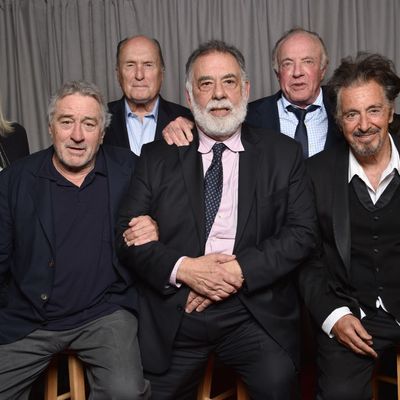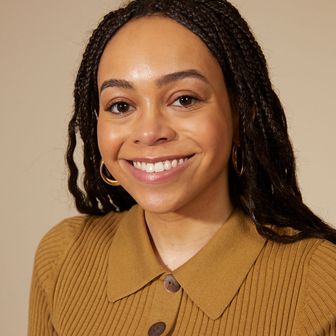
Diane Keaton never paid much attention to The Godfather. “I always felt like I was the most outsider, weird person,” she told her Godfather I and II castmates at the Tribeca Film Festival’s 45th anniversary screening. “Like, Why was I cast again? But then, I had a couple good scenes with Al.” Onstage at Radio City Music Hall, American cinema’s most famous family reunited: Keaton, Francis Ford Coppola, Al Pacino, James Caan, Robert Duvall, Talia Shire, and Robert De Niro talked and laughed (sometimes over one another), in a conversation moderated by Ray director Taylor Hackford.
The Radio City audience had just watched both legendary films on the big screen, and Keaton was excited to share that she, too, had recently rewatched the first movie. “I saw it on my computer. And I hadn’t seen it for about 30 years. I looked at Godfather I and I couldn’t get over it. It was so astonishing. Francis, it was so beautiful,” she said. Coppola said he’d seen the first movie more recently to work on the restoration, but he hadn’t seen the sequel in a long time. “I found it to be a very emotional experience,” Coppola said. “There’s a lot I forgot about the making of it.”
It’s an infamous story now, but production on Godfather I was beset with drama and strife from the studio. Coppola said he wasn’t a fan of Mario Puzo’s novel — “I thought the book was a little bit of a potboiler on the first reading” — and he was always fearful of being fired. The director insisted on Pacino’s casting as the lead, and it put them both on thin ice. “The studio didn’t want me after they hired me,” Pacino recalled. “I was living on 90th and Broadway at the time. I walked to the Village and back; I did it every day, thinking about this role. Just thinking where I could go with it. I came, and started filming it. I was dizzy. I was new to film. We were theater actors.” Coppola said Robert Evans, Paramount’s head of production at the time, wanted Robert Redford for the role. “Evans wanted someone who looked like him to play Michael,” the director said. Coppola looked over at Pacino, seated to his left, and smiled. “I wanted someone who looked like me.”
A Godfather cast reunion wouldn’t be complete without remembering the patriarch: A portrait of Marlon Brando in character as Vito hung onstage, overlooking the cast. Caan and Duvall remembered pulling stunts on set to make Brando laugh. “During the wedding scene, we were all mooning each other!” Duvall said, to laughs. Brando liked to be directed simply, Coppola said, and intentionally mumbled his lines. “Brando mumbled deliberately. He told me that when he does his lines, he tries not to move his mouth very much, so it’s easier to loop any lines you want in,” Coppola said. De Niro was quieter during the conversation, but said he would watch Brando’s scenes from the first movie over and over again to prepare. “I looked at the footage in a scientific way. I had to find spots where I could imitate what he was doing. I enjoyed it.”
With all these Corleones on one stage, when Hackford’s questions seemed too concentrated on the production of Godfather I, the audience began shouting out their own ideas. “The baptism scene,” shouted someone in the mezzanine. “What are your favorite scenes?” yelled someone in front. But this was a reunion, not a press conference — so after all these years, the best memories slipped out surprisingly. Keaton was floored by Shire’s performance, which prompted Coppola to share a detail she hadn’t heard before. “You know that very important scene where you tell Al that it wasn’t a miscarriage, that it was an abortion?” he said, referring to the scene in Godfather II. “That was Tali’s idea.” Shire smiled and shrugged, as Keaton seemed blown away.
Coppola closed the conversation with a familiar filmmaker lament: The Godfather — and everything that makes it spectacular — could never happen today, he said, because studios are only interested in big-budget tentpoles. “This film could be made today, but it wouldn’t get a go-ahead from a studio,” Coppola said. “The first film was made for about $6.5 million; the second was made for $11 or $12 million. It would never get a green light today.”


